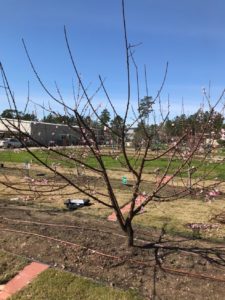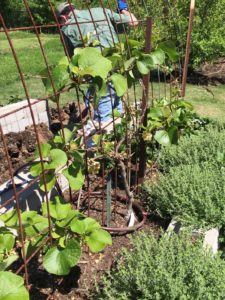
Currently under construction, this area will simulate backyard areas combining fruit trees with grass areas, shrubs, raised beds with vegetables, herbs and flowers. There will also be a demonstration area with several different grass trials to show how homeowners can incorporate lawns in their landscape.
Disease among the Grape Vines
May 17, 2019
On April 24th 2019 workday the master gardeners found two grape vines wilting and leaves falling off.
The Seibel grape vine, a French hybrid, had leaves showing the sign of water and nutrient deficiency plus other leaves with ” totally dead spots.” The other grape vine, an unknown variety, had all of its leaves wilting and falling off with no color change. All of the Muscadine planted nearby were healthy with all leaves normal.
After a little investigation it was determined that the vines were infected with Pierce’s disease.
Grape vines can be infected with this disease through its roots and by insects. Since these vines are over two years old, they are suspected to be infected by insects. This disease is prevalent in southeast Texas and the Texas A&M AgriLIFE Extention has published some very good articles on what variety of grapes can be planted that are resistant to the disease.
http://aggie-horticulture.tamu.edu/fruit-nut /files/2010/10/pd-grapes.pdf
Peach Tree Pruning:
A Texstar peach tree in the Agrilife Orchard Demonstration Garden was pruned on 2/13/19. This tree is starting its third year in the ground. The “before” picture shows that the tree is fairly dense and definitely too tall.
As usual, the first pruning was to remove dead, diseased or damaged branches; this pruning can be done any time of the year. After this, we look for crossing branches, which will rub each other, opening the bark to disease. When removing a crossing branch, you have to decide which one of the two to remove. For peach trees in our area, Agrilife recommends that the interior branches be removed so that the tree looks like an empty vase or wine glass. This allows better air flow in the tree reducing the incidence of fungus. This open area also allows more sun on new growth, which has the fruiting buds for next year’s crop. Remove a crossing branch that contributes to the open vase. After the crossing branches are removed, we take out any branches facing into the center to the “vase.”
If some branches have grown so much that a ladder is needed to reach any fruit or to spray, we remove the tall branches. Peach trees that have been pruned according to Agrilife recommendation are vigorous growers, so pruning for height should be done as needed between February and October. The Southeast Peach Growing Guide by the University of Georgia says peach trees live longer if they are not pruned from October 1 to February 1 (http://extension.uga.edu/publications/detail.html?number=B1171). It is best to prune a tall branch back to the main limb, if practical. If not practical, prune a tall branch back to eye level or so, cutting the branch just above an outward facing bud. Hopefully this bud will produce a new branch that will not fill in the vase. The “after” view of the pruned tree and the cuttings are shown below shown. The flowering branches are good for display in your home.

Peach tree before pruning

Peach tree after pruning

Peach tree limbs and branches after pruning
Kiwi Vines in Bloom
Part of the Orchard/Turf Demonstration Garden is the Kiwi Arbor. Two vines were planted last year: a male and a female. The male started blooming recently as shown in these photos. The female vine has not started blooming yet. Growing these in Montgomery County is a unknown, since the variety in the garden requires 600 “chill” hours, nominally the number of hours between 45 F and 32 F. If successful, these vines will produce Golden Kiwis.

Kiwi vines in MCMGA orchard

Blooms on male Kiwi vine